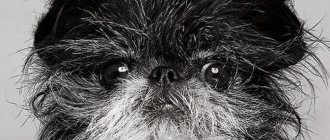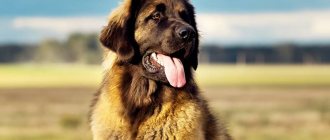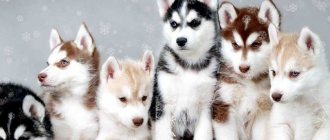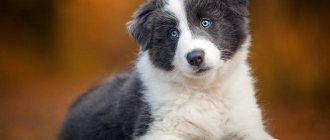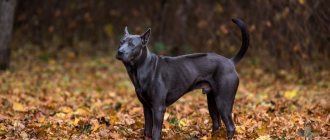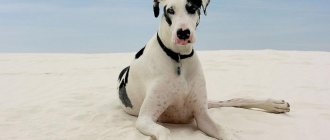| Origin: | England |
| Usage: | guard and guard dog, companion |
| Color: | brindle, fawn, red |
| Dimensions: | 61-68.5 cm, 41-59 kg |
| Lifespan: | 8-10 years |
Two centuries ago, England gave the world a canine treasure. In the homeland of fighting and hunting breeds, a fearless guard was born, a threat to thieves and robbers - the bullmastiff. The dog’s amazing working qualities, balanced temperament, devotion and extravagant appearance have won the hearts of thousands of owners in just fifty years. Today, these same traits are the reasons why millions of people fall in love with pets.
Standard requirements
A silent watchman, a fearless guard and a powerful bodyguard - these are all English bullmastiffs, the photos of which look truly terrifying. The dog is large, but at the same time fast and agile. He is calm, but behind the apparent phlegmaticity lies a threat, inflexibility and remarkable strength.
| Parameter | Official FCI standard |
| Height | 63.5-68.5 males, 61-66 cm females. |
| Weight | 50-59 kg males, 41-50 kg females. |
| Constitution | Knocked down, with prominent muscles and strong bones. The skin is raw, elastic, there are no folds on the body, wrinkles are allowed on the muzzle when the dog is excited. |
| Frame | Close to square format. The back is wide, straight, short, the loin is muscular and slightly convex, the croup is sloping. The neck is moderately long with dewlap and a beautiful scruff, the chest is voluminous, the belly is moderately tucked. |
| Head | Square, large, with a voluminous skull and a long muzzle. |
| Ears | Rose-shaped, V-shaped. Thin and short, standing high and wide. They fit tightly to the cheekbones, making the head appear even more square. |
| Eyes | They stand low, deep, straight and wide. The color of the iris is dark. There are black “glasses” around the eyes. |
| Nose | Black, flattened and wide, not snub-nosed. |
| Lips | Fleshy, with moderate jowls. Pigmentation is black. The upper lip overlaps the lower lip, but does not extend beyond the edge of the jaw. |
| Bite | Preferably straight, but heavy snacks are allowed. |
| Limbs | Straight, parallel, set wide. The length of the forelimbs is equal to half the height at the withers. The shoulder blades and hips are sloping, the elbows are adjacent to the body and directed back. |
| Paws | Collected into a ball, round, with short, strong and black claws. |
| Tail | Set on high, carried below the level of the back, lowered when at rest. The length is medium, the base is wide and gradually tapers towards the end. Covered with short hair. |
| Wool | Short, without waves or frays. It fits tightly to the body, there is no undercoat. |
| Suit | Red of any shade (bright, rich, golden, dark, light), fawn or brindle color. The latter comes in two types: deer or with a black mask on the face. A small white spot on the chest is allowed. |
Key points in training
First of all, puppies are taught a place to sleep, bowls, and feeding times. After vaccinations, you can set specific walking times. You need to raise a dog with a tight grip, but at the same time without aggression, assault or harsh methods. Bullmastiffs can be stubborn, but if the owner gains authority, then obedience is guaranteed.
Read about how to properly train a dog in the article: “Training a puppy: effective methods from dog handlers, learning commands at home.”
For a breed of this size, knowledge of the basic commands is mandatory:
- "Near";
- "Place";
- "It is forbidden".
It is necessary to achieve unquestioning obedience, this will help in case of conflict with pets or people.
Aggressive behavior should not be encouraged; on the contrary, the dog should be punished.
Psychological picture
The character of the Bullmastiff is phlegmatic. But behind the apparent mask of indifference lies constant vigilance. As soon as something unusual happens, the English defender, who just a second ago was snoring peacefully on the sofa, will stand next to the owner, ready to repel any danger.
The bullmastiff dog breed was bred for protection. This means that the pet is always “monitoring” the territory for threats. But he is not aggressive towards people: the dog will never attack a passerby, unless with the permission of the owner.
The people-oriented approach is visible in the work. Even in the face of obvious danger, the English Bullmastiff will first establish eye contact with the owner, and only then will he act.
The character of the pets is incredibly affectionate. They quickly get used to the family and love it when all “their” people are at home. But they can be left alone for a short time - dogs do not perceive several hours of separation as a disaster.
If the owner takes a leadership position, he will become the undisputed authority for the English Bullmastiff. The pet will do everything the owner says and will endure any “bullying”, even painful injections.
English Bullmastiffs are even-tempered, calm, alert in crowded places and playful at home. In the family circle they are loving, gentle and mischievous. Dogs cuddle like cats and fool around like 3-year-old children.
Four-legged bodyguards are capable of making their own decisions in extreme situations. They are naturally intelligent and thinking dogs. Yes, dogs always focus on their owner. But if he orders something dangerous, from the pets' point of view, they won't do it.
Character
The Bullmastiff is primarily a guard dog, a service animal. These dogs successfully worked in the police, were engaged in watchdog and search activities. Their character harmoniously combined swiftness, energy and desperate courage with boundless love for people.
Excellent protective qualities are inherent in this breed at the genetic level, but there is no excessive ferocity in the dogs. They are reserved, have excellent self-control and an even character. Owners speak of bullmastiffs as thinking dogs - capable of understanding the owner and his mood without words. Another excellent feature of these dogs is the ability to assess a situation and make an independent decision.
These dogs are very sociable and loyal. They constantly feel the need for communication and immediately notice if the owner is indifferent or neglects them. This can cause psychological trauma to your pet. However, these dogs are not intrusive. They are quite delicate and understanding.
Application
Initially, the Bullmastiff breed was a guard and watchman. These qualities are still passed on from litter to litter. It is in the dogs’ blood to protect their owners – English bodyguards do this even without special training.
Pets' watchdog qualities are worse than their guard qualities. Bullmastiffs live for and for the sake of their owner. And property doesn’t seem important to dogs.
From the point of view of safety for others, this pet is the best bodyguard. He has no malice towards people. His task is simply to eliminate the danger, to distance it from the owner. The dog will stand between the person and the perceived threat and try to remove the ill-wisher. And if this does not help, he will knock down the aggressor and hold him (but not bite him!) until the owner orders.
However, you should not tease a bullmastiff. If he feels danger, he will certainly attack.
At the beginning of the 20th century, the breed began to be used in the police and army. Dogs still help law enforcement agencies today. Strong, resilient and fearless dogs search for and catch criminals, detect explosives and drugs, and search for people under rubble.
Dogs are bred as companions with bodyguard qualities. They are preferred by people living in disadvantaged areas. With these brave defenders, it’s not scary to walk down dark alleys and let your children go for a walk.
History of the origin of the species
The Bullmastiff is a truly English breed of dog, bred relatively recently (late 19th century). At that time, cases of poaching in the forests became more frequent; attackers not only tried to escape from the law, but also harmed rangers. An assistant was needed who was fast, brave and strong.
To do this, foresters crossed the Old English Bulldog and Mastiff. The new dog became ruthless and strong, tearing apart the enemy in a matter of minutes. This categorically did not suit the authorities; it was decided to re-educate the Bullmastiff. Fierce individuals were culled, pets were trained and raised.
In addition to tracking down poachers, Bullmastiffs were also involved in guarding homes and serving in the police.
The breed received its first recognition in 1924 by the English Kennel Club. America recognized it in 1933, and a standard was written in 1935.
Socialization
Bullmastiff dogs are suitable for families with children and single people. They know how to adapt to the pace of life of their owners. But dogs are not recommended for older people and athletes. The former will not be able to cope with powerful, sometimes stubborn pets. But long hours of jogging and hiking are not for these phlegmatic giants.
English Bullmastiff and children over 10 years old get along well. The dog loves to play with the guys, provided that they know how to treat their four-legged friend. It is not recommended to leave children alone with a pet. He is patient and forgiving. But there is a problem - the large size of the pet: it can accidentally touch, push or crush the child.
The English guard is indifferent to friends and family acquaintances. True, he will not let the guests out of his sight - in case they want to offend the family. But strangers should not be familiar with the dog - it will perceive it as a threat.
The English Bullmastiff lives in perfect harmony with other pets. He has weak hunting instincts: the aristocratic Englishman does not chase cats, and is indifferent to birds, rodents and reptiles.
Relationships with relatives develop differently. English Bullmastiff males are aggressive towards each other and every day they arrange showdowns called “who is the boss of the house.” Pets get along better with other breeds and females.
Mating
Bullmastiffs are a breed whose puppies will not provide commercial profit. Raising a dog requires you to spend much more than it is worth. There are both pros and cons of mating. If both dogs are famous, have suitable characteristics and the conditions for keeping the puppies are ideal, then you can safely untie them. Otherwise, mating will be useless, especially if there is no demand for the breed.
Puberty occurs at 18-20 months. The bitch is bred on her third heat (13-15 days from the beginning). The signs are:
- Swollen loop;
- The discharge is light and translucent;
- The girl invites by moving her tail, hips, and spreading her paws wide.
Animals are checked for diseases and cleared of parasites within 2 weeks. It is important to choose dogs that complement each other (deficiencies are corrected, good qualities are enhanced). For the first time, you can invite a specialist.
Pets are walked together. The act must take place on the territory of the dog, subject to the availability of free space. The process itself may take from 5 to 20 minutes, and there may not be a lock. Repeated mating is scheduled after 2 days.
Upbringing
Bullmastiff puppies take a long time to mature psychologically. Even a 3-year-old English bodyguard behaves like a silly little kitten or a junior. This is a breed trait, so you will have to be patient.
Basic principles of raising the Bullmastiff breed:
- no training for up to six months - this time is allocated to raising the puppy, explaining norms of behavior, socialization;
- from 7-8 months they undergo a general training course (OCD);
- after 2 years, special classes are shown - protective guard service (PSS), search and rescue service (PSS);
- Among sports disciplines, canicross, fetching, and dogpulling are suitable.
The characteristics of the breed include some willfulness, but not stubbornness. English Bullmastiffs are serious in their studies, study diligently and steadfastly endure monotonous repetitions of commands. However, breaks and game lessons are not superfluous.
Take into account that the pet is slow. Plus, he needs to comprehend each command and learn everything about it: why it is needed, what will happen if it is executed, what is the best way to do it, and whether it is necessary to do it at all, etc. He can spend a long time in such thoughts until the owner distracts his attention or switches to another activity.
The English Bullmastiff needs an owner with a strong character, great willpower and great patience. It’s not the dog’s stupidity that’s annoying – the breed is very smart. The majority of owners are nervous because of the slowness. If a person is choleric, it is better for him to choose another dog.
Bullmastiff puppies cost
On average, the price of such a dog varies from 10,000 to 40,000 thousand rubles, it all depends on where the bullmastiff puppies were purchased. You can buy it second-hand, without a pedigree, for less than 10,000 thousand rubles. If a dog is chosen for protection, then it is better to give preference to specialized kennels. To avoid further problems, when purchasing, you should study all documents: from pedigree to medical certificates.
The Bullmastiff is one of the calmest, most intelligent dogs, which, with proper training, will become not only an excellent bodyguard and security guard, but also an irreplaceable friend. The main thing to remember is that dogs also have their own individuality, so each of them requires a special approach.
Share on social media networks
Interesting Facts
There are some interesting facts about the English Bullmastiff breed:
- At the dawn of the breed, bullmastiffs were called “lords of the forests” and “night dogs of huntsmen.”
- The only working population of dogs of this breed remains in the Republic of South Africa. Here they guard the De Beers diamond mines. Dogs are considered the best watchdogs, and this is in the homeland of the fearsome Boerboels.
- The English football team Arsenal adopted an English bullmastiff as their mascot. Before each game, the players brought a dog named Gunner onto the field. The dog's menacing appearance tempered the ardor of fans, unnerved opponents and energized team members.
- The English Bullmastiff's tail is called a fighting tail. He's massive, always moving. If the pet is very excited, it swings it so that it knocks objects onto the floor and leaves bruises on people's bodies. The dog does not do this on purpose, but such an excessive expression of joy can knock a 1-2 year old child off his feet.
- Although the standard excludes uncontrolled aggression and a tendency to bite, cases of English bullmastiffs attacking people have been recorded.
Breeding
They take bullmastiff breeding seriously - they first undergo a full veterinary examination and undergo deworming. They carefully choose a partner for mating, focusing not only on his pedigree and health status, but also on his behavior.
- Estrus. The first heat in bitches begins at seven to ten months. By this age, the dog is not yet formed and is not ready for mating - health problems will arise, the puppies will be born weak. Bullmastiff bitches are allowed to breed no earlier than 20-22 weeks.
- Knitting. Estrus lasts 10-15 days, in rare cases - up to 25 days. Mating is carried out from the seventh to the 12th day, when the bloody discharge is replaced by light mucous.
- Pregnancy. The duration of pregnancy is 63 days. Puppies are born viable from 53 to 68 days. If labor does not occur during this time, the issue of performing a caesarean section is decided. The diet of a pregnant dog is enriched with cottage cheese, fermented milk products, and special vitamins. In the second half of pregnancy, the duration of walks is reduced, and active games are avoided.
- Childbirth. Before giving birth, the dog becomes restless and its body temperature drops. Childbirth in most cases proceeds without complications. If this is your dog's first litter, it's a good idea to talk to your veterinarian beforehand and keep your phone handy just in case.
Contrary to popular belief, bearing and giving birth to offspring does not improve a bitch’s health. If you do not plan to seriously engage in breeding, the dog should be sterilized
SALUKI: DESCRIPTION OF THE BREED AND CHARACTER OF THE DOG
GAMPR: HISTORY OF ORIGIN AND CHARACTER OF THE DOG
KUVAS: HISTORY OF THE BREED AND CHARACTER OF THE DOG
LEONBERGER: HISTORY OF ORIGIN AND CHARACTER OF THE DOG
Features of maintenance and care
The Bullmastiff breed gets along everywhere - in a house, apartment and enclosure. The main thing is that the room is spacious, warm and draft-free.
An English Bullmastiff cannot be chained. Its goal is to protect the one and only owner, and not material things that can be bought in dozens. The pet needs to constantly communicate with the family - only then will it become a devoted and loving dog.
Pets shed little and are moderately slobbery, compared to bulldogs. But there is enough fur and discharge from the mouth. Plus, due to the brachycephalic shape of the head, dogs wheeze loudly, snore and pass gas.
Pets have a deafeningly loud voice. Fortunately, they are silent and rarely “delight” their neighbors with their booming bass. English Bullmastiffs bark only in emergency situations.
Another advantage of pets is that they are calm. Dogs of this breed will not move around and demand attention. At home they will find softer furniture and fall asleep.
Grooming
Caring for English Bullmastiffs is easy. But there are features:
- comb bullmastiffs 1-2 times a week with a massage brush, during the molting period - 4-5 times a week;
- examine ears and eyes daily, promptly remove dirt, sulfur, and nitrous oxides from them;
- the muzzle is wiped after each meal;
- after walks, inspect the paw pads - dogs often injure and prick them;
- trim the claws every 3-4 weeks;
- brush your teeth every 4-7 days;
- Like all large dogs, English Bullmastiffs often develop calluses on the elbows and hock joints - they are softened with oily vitamins A, E, Dioxidine solution, glycerin or lanolin ointment;
- Not all English bullmastiffs have correct ears - their set is corrected with mineral and vitamin supplements, glucosamine, chondroitin, massage, and sometimes the ears are “glued up.”
Bathing
The English Bullmastiff does not need to be washed frequently. The dog is bathed only when he is dirty or has a strong dog smell.
Use hypoallergenic zoo shampoo for short-haired dogs. In the bathroom, try not to get your ears, eyes and nose wet. After bath procedures, do not take your pet outside for 2-3 hours. In winter, regular washing is replaced with combing with dry shampoo.
Washing an English Bullmastiff is not easy due to its size. Fortunately, the breed loves to bathe and happily jumps into the bathtub.
After walks, wash the paws, wipe the face and fur with a damp sponge if they are dirty.
In summer, the pet loves to splash around in ponds. After such entertainment, you need to rinse it with clean water from the shower or from a hose.
Walk
The Bullmastiff dog is moderately active. Often the pet prefers to lie at home for an extra hour than to run circles around the neighborhood. Therefore, the animal is forced to move. The optimal loads for him are short running, walking, and exercises at the training ground.
Due to their heavy weight, English Bullmastiffs cannot take hurdles - fractures, sprains, and tendon ruptures are possible. And puppies up to 4-4.5 months are carried down and up the stairs by hand - their joints and bones are still forming, and such loads will lead to deformation of the musculoskeletal system.
How long you need to walk your pets depends on age and weather. So, the first walks of puppies last 5-15 minutes 2-4 times a day, for adult dogs - 1.5-2 hours twice a day. In hot and cold weather there are fewer people outside.
It is impossible to let physical development take its course and be led by the laziness of English bullmastiffs. The breed is prone to obesity, and exercise is the best prevention of excess weight.
Feeding
The diet of the Bullmastiff breed is standard. They are fed balanced natural food or holistic or super-premium food.
English Bullmastiffs are prone to food allergies. Therefore, corn and its derivatives, wheat, barley, soybeans, chicken, products with chemicals - preservatives, flavor enhancers, etc. are excluded from the diet.
How much pets eat depends on age, size and time of year:
- the volume of natural diet for puppies is 6% of the dog’s weight;
- for an adult dog – 4%: a pet weighing 50 kg eats 2 kg of food per day;
- in the heat, pets often refuse heavy food - they replace it with fermented milk products.
English Bullmastiffs are sloppy eaters. They drop food, spill water, and scatter food on the floor. Place a rubberized mat under the bowls and wipe it with a damp cloth after each meal.
Rating of dog handlers
Experts from the website lapkins.ru, based on a five-point rating system, have compiled the following characteristics of the bullmastiff.
- The need to pay attention to caring for the dog is minimal – 1 point.
- Two points were given for activity, shedding, friendliness and noise made by the dog.
- The dog's health, ability to be alone, ability to train, aggressiveness and general intelligence are rated three points.
- Bullmastiffs received the highest marks for their excellent guard qualities and high cost of maintenance.
Health
The life expectancy of the Bullmastiff is short. On average they live 10 years. Some representatives of the breed celebrate their 12th and 13th birthdays.
Diseases
How long bullmastiffs live depends on whether they have congenital or acquired pathologies. If a serious illness is discovered, the animal will not live to reach 8 years of age.
Dogs are susceptible to:
- dysplasia;
- dislocations;
- volvulus of the stomach and intestines;
- gonarthrosis;
- dermatitis – contact, interdigital;
- eczema;
- alopecia;
- lymphoma;
- inversion and eversion of the eyelids;
- urolithiasis;
- stenosis of the heart muscle;
- panosteitis.
Vaccinations
Animals are vaccinated against:
- rabies;
- plague;
- parvovirus;
- enteritis;
- herpes;
- leptospirosis.
A bullmastiff puppy is susceptible to viral infections like no other breed, so it is not taken outside until the end of the vaccination quarantine at 3-4 months.
Prevention
An annual visit to the veterinarian is required. Conduct a full examination of the dog to identify diseases or abnormalities.
How to choose a kitten
Before purchasing check:
- kennel documents on membership in the Russian Cynological Federation (RKF), permission for breeding;
- what does a bullmastiff sire look like: evaluate the exterior of the bitch and the dog, their appearance;
- where the bullmastiff puppy and his parents are kept: the ideal room is spacious, warm, draft-free, clean;
- everything about the puppies’ parents: pedigrees, certificates, awards, titles, veterinary passports, certificate of testing for dysplasia of the elbow and hip joints (marks A or B are required);
- appearance of the puppy: a healthy kitten of 2 months weighs 9-10 kg, 3 months - 17 kg, with clear eyes and ears, a tail without creases, paws of a U-shaped rather than a V-shaped set.
Pet and breeding class puppies are taken at 3-3.5 months, when all vaccinations have been completed and vaccine quarantine has ended. The future show-class champion is taken from six months, when exterior features appear.
Breed traits
Breed traits (on a 5-point scale)
| Bullmastiff | |||
| Activity | in the house | 1.3 | |
| on the street | 2 | ||
| Obedience | training | 4.7 | |
| strangers | 4.7 | ||
| Domination | in family | 2.3 | |
| over dogs | 3 | ||
| Defending your territory | from people | 3 | |
| from dogs | 3 | ||
| Sociability | in family | 4.7 | |
| with strangers | 4.3 | ||
| with dogs | 3.3 | ||
| Concentration | in family | 2 | |
| in front of strangers | 2 | ||
| with dogs | 2 | ||
| Aggressiveness | in family | 1 | |
| to strangers | 1.3 | ||
| to the dogs | 2.3 | ||
| to cats | 1.7 | ||
| Family behavior | calmness | 4.7 | |
| demand for affection | 4.3 | ||
| excitability | 2 | ||
| playfulness | 3.7 | ||
| excessive barking | 1 | ||
| behavioral breakdowns | 1.7 | ||
| Tolerance for children | up to 4 years | 4.3 | |
| over 4 years old | 4.7 | ||
| Institutional use | watchman | 3.3 | |
| bodyguard | 2 | ||
This breed is often compared to the following dog breeds: Cane Corso, Dogue de Bordeaux (French Mastiff), English Mastiff, Rottweiler, German Boxer.
The photographs show what bullmastiffs look like:
Preparing a place for a pet
Before the puppy arrives at the apartment, you definitely need to think about where he will be and arrange his corner in advance. Since the Bullmastiff is a large dog, the location must be appropriate. It is necessary to choose an area where the dog can stretch out to its full height. It is better to lay a soft bed in the hallway. If choosing a place is difficult, you can give the right to the pet itself. The puppy will settle down where it will be convenient and comfortable.
The only thing worth remembering is that the pet’s place should not be near the radiator or near the front door. In the first case, the animal may overheat, and in the second there is a risk of blowing out. The bed must be soft, with a dense lower part and small sides: animals love to rest their heads on them, like on a pillow.
Color
Dog handlers distinguish two categories of colors for this breed - one-color and two-color.
In the first group, any shades must be uniform. Small white spots on the chest are allowed. The black “mask” near the tip of the muzzle has a deep color that gradually “blurs” in areas near the eyes.
The second category is divided into two subtypes: two-color and multi-color colors.
The color of two colors involves solid coloring with the presence of white or dark spots.
In the multi-color version, the spots are located in certain places and have different shades.
Feed
The dog's health depends on a properly formulated diet. A dog weighing up to fifty kg should eat a couple of kilograms of food per day. Most of the diet consists of meat and fish, and only about eight hundred grams are cereals and vegetables.
Experts recommend giving your dog stringy, lean meat with a lot of cartilage.
You should feed your pet either before a walk or immediately after it.
Important!
- Do not mix raw food with boiled and fried food.
- During hot weather, dogs often refuse to eat. In this case, you should give your pet kefir, fermented baked milk and as much water as possible.

